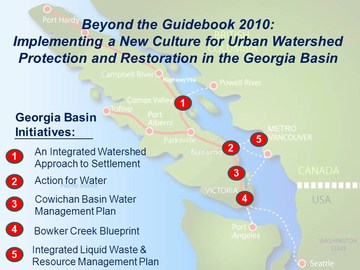OKANAGAN RAIN TO RESOURCE WORKSHOP: The Bowker Creek Blueprint demonstrates what can be accomplished through a vision, alignment and collaboration – Jody Watson
Note to Readers:
The purpose of Day 2 of the ‘From Rain to Resource Workshop on October 29 in Kelowna is to integrate the perspectives of the people working on-the-ground and those developing and adopting policy. One of the case studies is the Bowker Creek Blueprint, an initiative of the Capital Regional District and three municipalities – Victoria, Saanich and Oak Bay. Jody Watson will tell the Bowker story.
Jody Watson is Chair of the Bowker Creek Initiative; and Harbours & Watersheds Coordinator with the Capital Regional District.

A 100-Year Action Plan
“The Bowker Creek Urban Watershed Renewal Initiative, known by the acronym BCI, is a multi-jurisdictional collaborative effort between local government, community groups, post-secondary institutions and private citizens to improve the health of Bowker Creek and its watershed,” states Jody Watson.
“The BCI has developed the Bowker Creek Blueprint: A 100-year action plan to restore the Bowker Creek Watershed to provide member municipalities, the Capital Regional District, the community and other land stewards with information and guidance to manage and restore the watershed and creek corridor over the long term – for example, 50 to 100 years.”
Actions at Two Scales
“Recommended actions are provided at two scales: watershed management activities and policies, and site-specific actions for each of 17 creek corridor reaches. The Blueprint is to be implemented over a period of decades in recognition that change can be slow in the urban environment.”
“Have an action plan in place will ensure that positive changes can happen incrementally and that opportunities for major improvements can be realized as they arise. The key factors to the BCI success, the challenges and barriers and how the BCI navigated through the rough waters to complete the development of the Blueprint will also be discussed at the Okanagan workshop.”
Beyond the Guidebook 2010
The Bowker Creek Blueprint is referenced throughout Beyond the Guidebook 2010: Implementing a New Culture for Urban Watershed Protection and Restoration in British Columbia because the Bowker Creek experience demonstrates what can be accomplished when community groups and municipal staffs coalesce around a shared vision and shared values.
Released in June, Beyond the Guidebook 2010 demonstrates that the practitioner culture is changing as an outcome of collaboration, partnerships and alignment; and provides local governments with ‘how to’ guidance for developing outcome-oriented urban watershed plans.
To Learn More:
Click on Beyond the Guidebook 2010: Implementing a New Culture for Urban Watershed Protection and Restoration in British Columbia — There is now clear guidance for aligning local actions with provincial and regional goals to ‘design with nature’ so that British Columbians can create greener communities, live water smart and prepare for climate change.

The Bowker Creek Forum
The Bowker Creek Forum on February 23, 2010 was a celebration of the Bowker Creek Blueprint. Because the Blueprint accomplishment is of provincial significance, the Forum was also an opportunity for inter-regional learning.
Collaboration and Sharing
“The Bowker Creek Forum created an opportunity for local municipal staff and others to learn about urban watershed management successes and challenges from the Bowker Creek Initiative,” states Jody Watson. “The Forum also  provided the opportunity to celebrate what we have accomplished through commitment and perseverance.”
provided the opportunity to celebrate what we have accomplished through commitment and perseverance.”
“The Bowker Creek Forum also created an opportunity for champions from the Capital Region to connect with champions from ‘north of the Malahat’, and also with champions from Metro Vancouver,” continues Kim Stephens, Program Coordinator for the Water Sustainability Action Plan for British Columbia.
A Provincially Significant Demonstration Initiative
The Bowker Creek Initiative demonstrates HOW a ‘regional team approach’ can enable action at a watershed scale that results in coordinated and integrated changes on the ground.
 “Other watershed initiatives and other jurisdictions can benefit from the trail-blazing efforts of the Bowker Creek Initiative. Effective sharing of their experience can potentially accelerate the change process elsewhere in the Georgia Basin,” observes John Finnie, Chair of Convening for Action on Vancouver Island, known by the acronym CAVI. John Finnie is General Manager of Regional and Community Utilities with the Regional District of Nanaimo.
“Other watershed initiatives and other jurisdictions can benefit from the trail-blazing efforts of the Bowker Creek Initiative. Effective sharing of their experience can potentially accelerate the change process elsewhere in the Georgia Basin,” observes John Finnie, Chair of Convening for Action on Vancouver Island, known by the acronym CAVI. John Finnie is General Manager of Regional and Community Utilities with the Regional District of Nanaimo.
“Based on my experience over the past 30-plus years, the Bowker Creek Blueprint has gone well beyond any other plan in terms of how it has achieved consensus and galvanized commitment to move from planning to action on the ground,” adds Kim Stephens
An Inspiring Accomplishment
 “The Bowker Creek Blueprint is an outstanding and inspiring accomplishment,” states Eric Bonham, a founding member of CAVI and a former Director in two provincial Ministries. He is also Past-Chair of the Highlands Stewardship Foundation.
“The Bowker Creek Blueprint is an outstanding and inspiring accomplishment,” states Eric Bonham, a founding member of CAVI and a former Director in two provincial Ministries. He is also Past-Chair of the Highlands Stewardship Foundation.
“The Bowker 100-Year Action Plan demonstrates how a ‘top down bottom up strategy’ leads to practical action. It has the power to positively influence what happens in other parts of the Georgia Basin.”
To Learn More:
Click on Bowker Creek Blueprint: Water Bucket stories profile precedent-setting initiative for urban watershed restoration in the Georgia Basin — Major breakthroughs happen when decision makers in government work with grass-roots visionaries in the community to create desired outcomes. Leading up to the Bowker Creek Forum in February 2010, a set of four stories progressively foreshadowed and/or elaborated on what would be covered at the Forum. A fifth story documents the Forum outcomes.
Click on Bowker Creek Blueprint brings new meaning in British Columbia to the Ian McHarg vision for “designing with nature” — The Blueprint is a 100-year action plan to make the watershed restoration vision real. Watershed restoration is a long-term commitment. The Bowker Creek Blueprint is all about stakeholders committing to actions on the ground, one reach and one property at a time, over the next 100 years.


